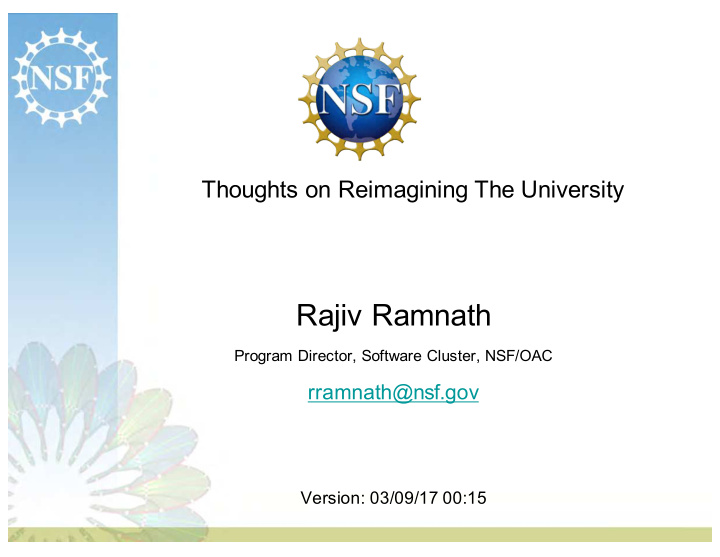



Thoughts on Reimagining The University Rajiv Ramnath Program Director, Software Cluster, NSF/OAC rramnath@nsf.gov Version: 03/09/17 00:15
Workshop Focus • The research world has changed - how • The university needs to adapt its structure, mission, infrastructure, education, recruitment. • Recognize new types of research outputs - software and data • Adapt research staffing and give research staff a place in academia • Tailor measures of success for faculty active in open science/open research • Make universities competitive to attract the best students, staff, and faculty How can NSF support this – from an Research Cyberinfrastructure and Software Perspective? 2
We Are Driven By Big Science - NSF Big Ideas • Understanding the Rules of Life: Predicting Phenotype • Work at the Human-Technology Frontier: Shaping the Future • Mid-scale Research Infrastructure • Windows on the Universe: The Era of Multi-messenger Astrophysics • Navigating the New Arctic • Harnessing Data for 21st Century Science and Engineering • The Quantum Leap: Leading the Next Quantum Revolution • Growing Convergent Research 3
Our Priorities Also Support Big Science • A National CI Ecosystem – Community establishment (directive to leverage Institutes) – Sustainability – Building on existing assets – Towards an infrastructure “platform” • Enabling Robust and Reliable Science – Repeatability -> Replicability -> Reproducibility – Uncertainty quantification – Software publication, citation – Education 4
We are Looking to the Future of Computing – the 5 NSCI Objectives 1. Exascale computing system… – Foundational work on science, algorithms, programming environments, system software, architecture, and performance evaluation 2. Increasing coherence between … simulation and data analytics… – Science and technology that use and enable applications involving both computational simulation and data analysis. 3. A viable path forward … [in] the ‘post-Moore’s Law era – Foundational work on new device technology, fabrication methods, computer architectures, software techniques. 4. An enduring National HPC ecosystem… – Develop, integrate, and deploy building blocks of an HPC ecosystem. – Advance the organization, architecture applications of such a system, – Enhance user productivity, broaden participation, skilled workforce. 5. Public-private collaboration…” – Existing programs, such as GOALI, SBIR/SBTT, and IUCRC – Technology transition to and from practice – Advance the use of HPC technology in the commercial sector 5
Encouraging Convergence and Co-design Builds the Future Research Infrastructures Access HYPOTHESES Analytics Visualization INFORMATION High Performance Data Quality Computing DATA IN Collaboration CONTEXT Computational- Tools Mathematical - Science domains Exploratory Statistical Analysis Systems, Methods/Models algorithms Foundations DATA DISCOVERY Cyber infrastructure Workforce Experiments Data Collection Interpretation Benchmark Model Data Sets THEORY Validation Redesign 6
Our Initiatives Seek to Help Holistically Support Foundational CI Support Scientific Research and Research and Development Development with CI Influence Community, Policies, Environment for Sustainability of the Help Develop a CI Ecosystem Trained CI Workforce 7
Example: Software Programs Target the Research -> Production Pipeline • Research in Scientific Software • Computational and Data-Enabled Science & Engineering (CDS&E) • Critical Resilient Infrastructure Systems and Processes (CRISP) • Designing Material to Revolutionize and Engineer our Future (DMREF) • Exploiting Parallelism and Scalability (XPS) and Scalable Parallelism in the Extreme (SPX) • Development, Deployment of CI (lead) • Software Infrastructure for Sustained Innovation (SI2): • Discretionary investments: • Venture/Reuse Fund • EAGERs and RAPIDs • Workshops • Supplements including REU • Collaborations with other software programs: – Advances in Biological Informatics (ABI) – Metadata for Long-standing Large-Scale Social Science Surveys (META-SSS) – Geoinformatics Program in the Division of Earth Sciences (EAR) – Polar Cyberinfrastructure Program in Polar Programs – Critical Techniques, Technologies and Methodologies for Advancing Foundations and Applications of Big Data Sciences and Engineering (BIGDATA) – Integrative Graduate Education and Research Traineeship Program-CIF21 Track 8 (IGERT)
Example: Unique Criteria for Software Cyberinfrastructure Bring in the Full Range of Capabilities • Fill a recognized need in the science community • Create innovative, robust and reliable research capabilities in science and engineering for researchers • Embed research and innovation into the project activities • Use a comprehensive user-engaged management plan • Resourced by teams with credibility in engineering, and science • Build community through direct engagement • Progress towards sustainability after NSF funding has ended • Further a national CI ecosystem (reuse, integrate, adopt) 9
Embedded Research in CI Projects Creates Robust Insights that help Build Academic Reputations Systems Integration: – New integration techniques - auto-generation of integration code from interface specifications – Studies of software engineering methods for s/w integration – DevOps, continuous deployment – Studies of integrative methods for data science – Empirical studies on software reuse in science – Analytical models for understanding/evaluating performance, scalability, security during integration – Service-based integration of data analytics and HPC system architectures HCI: – Search based composition of services – Human-computer interfaces and interaction design and evaluation during integration - e.g. when “surprise" is a given SBE: – Ethnographic studies on how scientists actually work – Economic and social aspects of reuse – Economic and social aspects of integration – Science of team science in dynamic situations Education: – Learning theories for "just-in-time" application (novice vs. expert learning) Domain science: 10 – End-to-end composition of models across scales (neuron->cognition, chip->data center)
We Consider the Research Workforce as Infrastructure Professional Staff Cyber Scientists to support Area Scientists to develop new capabilities to exploit new capabilities new capabilities ACI 11
We Support The Career Pipeline • Goal: Build robust careers paths in Cyber- Infrastructure (CI) and Computational and Data- enabled Science and Engineering (CDSE) • Techniques: Leverage existing programs for early- stage researchers. Develop new programs in areas of need/challenge CAREER CURRICULA, Educational Resources CI-TraCS NRT/IGERT CRII CAMPUS RESEARCHERS CLIMATE REU Sites 12
Finally: We hope to learn from this workshop • Universities have to wrestle with how to make open science work for all their diverse research communities • What we learn here will inform our programs 13
Thanks!
Recommend
More recommend